wiper blades SUBARU LEGACY 2009 5.G Owners Manual
[x] Cancel search | Manufacturer: SUBARU, Model Year: 2009, Model line: LEGACY, Model: SUBARU LEGACY 2009 5.GPages: 447, PDF Size: 14.26 MB
Page 172 of 447
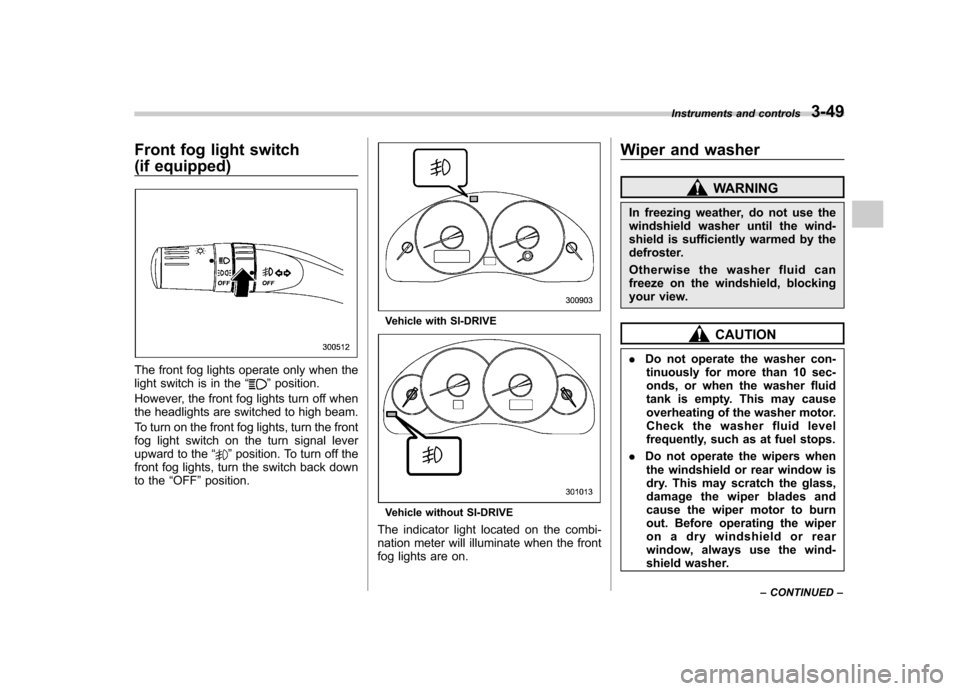
Front fog light switch
(if equipped)
The front fog lights operate only when the
light switch is in the“”position.
However, the front fog lights turn off when
the headlights are switched to high beam.
To turn on the front fog lights, turn the front
fog light switch on the turn signal lever
upward to the “
”position. To turn off the
front fog lights, turn the switch back down
to the “OFF ”position.
Vehicle with SI-DRIVE
Vehicle without SI-DRIVE
The indicator light located on the combi-
nation meter will illuminate when the front
fog lights are on. Wiper and washer
WARNING
In freezing weather, do not use the
windshield washer until the wind-
shield is sufficiently warmed by the
defroster.
Otherwise the washer fluid can
freeze on the windshield, blocking
your view.
CAUTION
. Do not operate the washer con-
tinuously for more than 10 sec-
onds, or when the washer fluid
tank is empty. This may cause
overheating of the washer motor.
Check the washer fluid level
frequently, such as at fuel stops.
. Do not operate the wipers when
the windshield or rear window is
dry. This may scratch the glass,
damage the wiper blades and
cause the wiper motor to burn
out. Before operating the wiper
on a dry windshield or rear
window, always use the wind-
shield washer. Instruments and controls
3-49
– CONTINUED –
Page 173 of 447

3-50Instruments and controls
.In freezing weather, be sure that
the wiper blades are not frozen to
the windshield or rear window
before switching on the wipers.
Attempting to operate the wiper
with the blades frozen to the
window glass could cause not
only the wiper blades to be
damaged but also the wiper mo-
tor to burn out. If the wiper
blades are frozen to the window
glass, be sure to operate the
defroster, wiper deicer (if
equipped) or rear window defog-
ger before turning on the wiper.
. If the wipers stop during opera-
tion because of ice or some other
obstruction on the window, the
wiper motor could burn out even
if the wiper switch is turned off. If
this occurs, promptly stop the
vehicle in a safe place, turn the
ignition switch to the “LOCK ”
position and clean the window
glass to allow proper wiper op-eration.
. Use clean water if windshield
washer fluid is unavailable. In
areas where water freezes in
winter, use SUBARU Windshield
Washer Fluid or the equivalent.
Refer to the “Windshield washer fluid
”section in chapter 11.
Also, when driving the vehicle
when there are freezing tempera-
tures, use non-freezing type wi-
per blades.
. Do not clean the wiper blades
with gasoline or a solvent, such
as paint thinner or benzine. This
will cause deterioration of the
wiper blades.
NOTE . The front wiper motor is protected
against overloads by a circuit breaker.
If the motor operates continuously
under an unusually heavy load, the
circuit breaker may trip to stop the
motor temporarily. If this happens, park
your vehicle in a safe place, turn off the
wiper switch, and wait for approxi-
mately 10 minutes. The circuit breaker
will reset itself, and the wipers will
again operate normally.. Clean your wiper blades and win-
dow glass periodically with a washer
solution to prevent streaking, and to
remove accumulations of road salt or
road film. Keep the washer button
depressed at least for 1 second so that
washer solution will be sprinkled all
over the windshield or rear window. .
Grease, wax, insects or other mate-
rial on the windshield or the wiper
blades results in jerky wiper operation
and streaking on the glass. If you
cannot remove those streaks after
operating the washer or if the wiper
operation is jerky, clean the outer sur-
face of the windshield or rear window
and the wiper blades using a sponge or
soft cloth with a neutral detergent or
mild-abrasive cleaner. After cleaning,
rinse the window glass and wiper
blades with clean water. The glass is
clean if no beads form on the glass
when you rinse with water.. If you cannot eliminate the streaking
even after following this procedure,
replace the wiper blades with new
ones. Refer to the “Replacement of
wiper blades ”section in chapter 11 for
replacement instructions.
Page 176 of 447
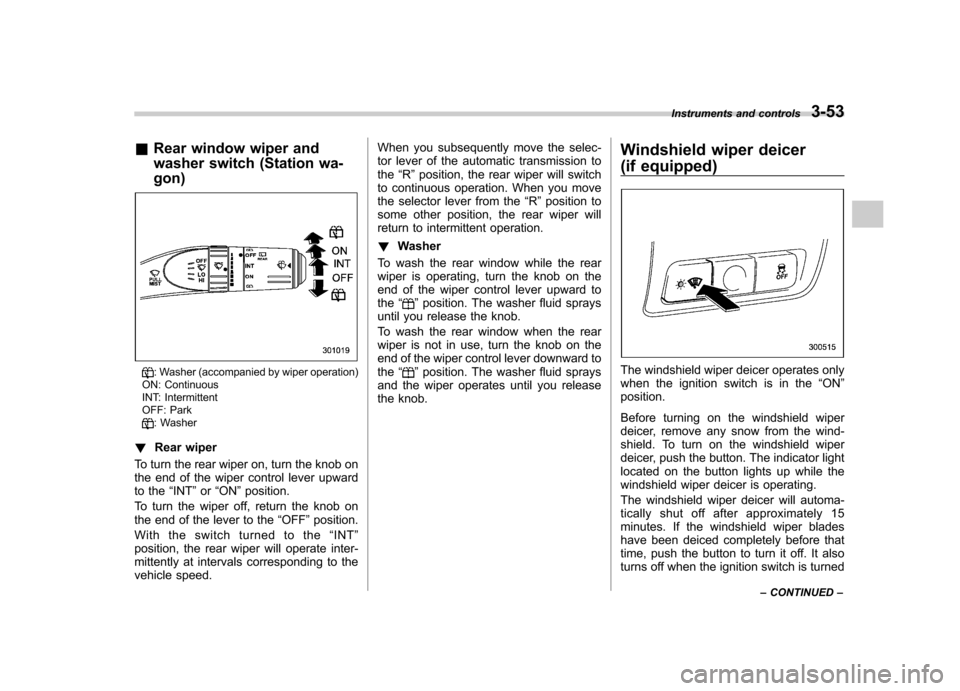
&Rear window wiper and
washer switch (Station wa- gon)
: Washer (accompanied by wiper operation)
ON: Continuous
INT: Intermittent
OFF: Park
: Washer
! Rear wiper
To turn the rear wiper on, turn the knob on
the end of the wiper control lever upward
to the “INT ”or “ON ”position.
To turn the wiper off, return the knob on
the end of the lever to the “OFF ”position.
With the switch turned to the “INT ”
position, the rear wiper will operate inter-
mittently at intervals corresponding to the
vehicle speed. When you subsequently move the selec-
tor lever of the automatic transmission tothe
“R ”position, the rear wiper will switch
to continuous operation. When you move
the selector lever from the “R ”position to
some other position, the rear wiper will
return to intermittent operation. ! Washer
To wash the rear window while the rear
wiper is operating, turn the knob on the
end of the wiper control lever upward tothe “
”position. The washer fluid sprays
until you release the knob.
To wash the rear window when the rear
wiper is not in use, turn the knob on the
end of the wiper control lever downward tothe “
”position. The washer fluid sprays
and the wiper operates until you release
the knob. Windshield wiper deicer
(if equipped)The windshield wiper deicer operates only
when the ignition switch is in the
“ON ”
position.
Before turning on the windshield wiper
deicer, remove any snow from the wind-
shield. To turn on the windshield wiper
deicer, push the button. The indicator light
located on the button lights up while the
windshield wiper deicer is operating.
The windshield wiper deicer will automa-
tically shut off after approximately 15
minutes. If the windshield wiper blades
have been deiced completely before that
time, push the button to turn it off. It also
turns off when the ignition switch is turned Instruments and controls
3-53
– CONTINUED –
Page 305 of 447
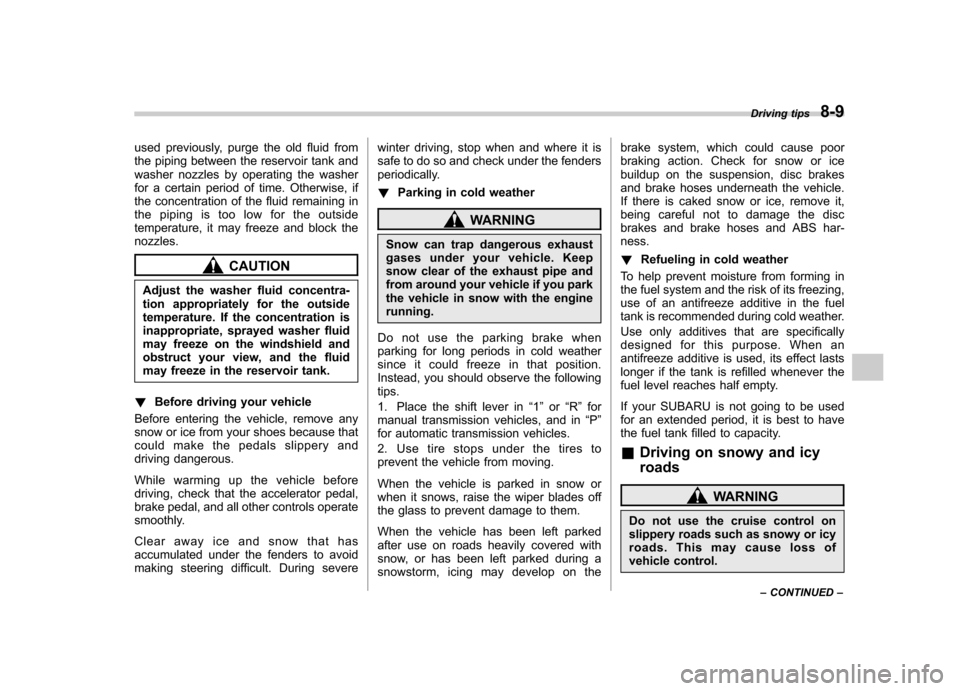
used previously, purge the old fluid from
the piping between the reservoir tank and
washer nozzles by operating the washer
for a certain period of time. Otherwise, if
the concentration of the fluid remaining in
thepipingistoolowfortheoutside
temperature, it may freeze and block thenozzles.
CAUTION
Adjust the washer fluid concentra-
tion appropriately for the outside
temperature. If the concentration is
inappropriate, sprayed washer fluid
may freeze on the windshield and
obstruct your view, and the fluid
may freeze in the reservoir tank.
! Before driving your vehicle
Before entering the vehicle, remove any
snow or ice from your shoes because that
could make the pedals slippery and
driving dangerous.
While warming up the vehicle before
driving, check that the accelerator pedal,
brake pedal, and all other controls operate
smoothly.
Clear away ice and snow that has
accumulated under the fenders to avoid
making steering difficult. During severe winter driving, stop when and where it is
safe to do so and check under the fenders
periodically. !
Parking in cold weather
WARNING
Snow can trap dangerous exhaust
gases under your vehicle. Keep
snow clear of the exhaust pipe and
from around your vehicle if you park
the vehicle in snow with the enginerunning.
Do not use the parking brake when
parking for long periods in cold weather
since it could freeze in that position.
Instead, you should observe the followingtips.
1. Place the shift lever in “1 ” or “R ” for
manual transmission vehicles, and in “P ”
for automatic transmission vehicles.
2. Use tire stops under the tires to
prevent the vehicle from moving.
When the vehicle is parked in snow or
when it snows, raise the wiper blades off
the glass to prevent damage to them.
When the vehicle has been left parked
after use on roads heavily covered with
snow, or has been left parked during a
snowstorm, icing may develop on the brake system, which could cause poor
braking action. Check for snow or ice
buildup on the suspension, disc brakes
and brake hoses underneath the vehicle.
If there is caked snow or ice, remove it,
being careful not to damage the disc
brakes and brake hoses and ABS har-ness. !
Refueling in cold weather
To help prevent moisture from forming in
the fuel system and the risk of its freezing,
use of an antifreeze additive in the fuel
tank is recommended during cold weather.
Use only additives that are specifically
designed for this purpose. When an
antifreeze additive is used, its effect lasts
longer if the tank is refilled whenever the
fuel level reaches half empty.
If your SUBARU is not going to be used
for an extended period, it is best to have
the fuel tank filled to capacity. & Driving on snowy and icy roads
WARNING
Do not use the cruise control on
slippery roads such as snowy or icy
roads. This may cause loss of
vehicle control. Driving tips
8-9
– CONTINUED –
Page 306 of 447

8-10Driving tips
CAUTION
Avoid prolonged continuous driving
in snowstorms. Snow will enter the
engine ’s intake system and may
hinder the air flow, which could
result in engine shutdown or evenbreakdown.
To prevent skidding and slipping, avoid
sudden braking, abrupt acceleration, high-
speed driving, and sharp turning when
driving on snowy or icy roads.
Always maintain ample distance between
your vehicle and the vehicle ahead of you
to avoid the need for sudden braking.
To supplement the foot brake, use the
engine brake effectively to control the
vehicle speed. (Shift into a lower gear
when necessary.)
Avoid shifting down abruptly. Such beha-
vior can cause the wheels to lock, possibly
leading to loss of vehicle control.
An anti-lock brake system (ABS) en-
hances your vehicle ’s braking perfor-
mance on snowy and icy roads. Refer tothe “ABS (Anti-lock Brake System) ”and
“ Vehicle Dynamics Control system ”sec-
tion in chapter 7 for information on braking
on slippery surfaces. !
Wiper operation when snowing
Before driving in cold weather, make sure
the wiper blades are not frozen to the
windshield or rear window. If the wiper
blades are frozen to the windshield or rear
window, use the defroster with the airflow
control button/dial in the “
”position and
the temperature control dial set for max-
imum warmth until the wiper blades are
completely thawed out. If your vehicle is
equipped with a wiper deicer, it is helpful
to thaw the windshield wiper blades. To
thaw out the rear wiper blade, use the rear
window defogger.
When driving in snow, if frozen snow starts
to stick on the surface of the windshield
despite wiper operation, use the defroster
with the airflow control button/dial in “
”
and the temperature control dial set for
maximum warmth. After the windshield
gets warmed enough to melt the frozen
snow on it, wash it away using the
windshield washer.
Snow stuck on the wiper arm prevents the
wiper from working effectively. If snow is
stuck on the wiper arm, pull off the road to
a safe place, then remove it. If you stop
the vehicle at road side, use the hazard
warning flasher to alert other drivers.
We recommend use of non-freezing type wiper blades (winter blades) during the
seasons you could have snow and sub-
zero temperatures. Blades of this type
give superior wiping performance in
snowy conditions. Be sure to use blades
that are suitable for your vehicle.
CAUTION
During high-speed driving, non-
freezing type wiper blades may not
perform as well as standard wiper
blades. If this happens, reduce the
vehicle speed.
NOTE
When the season requiring non-freez-
ing type wiper blades is over, replace
them with standard wiper blades. & Corrosion protection
Refer to the “Corrosion protection ”section
in chapter 10.
Page 352 of 447
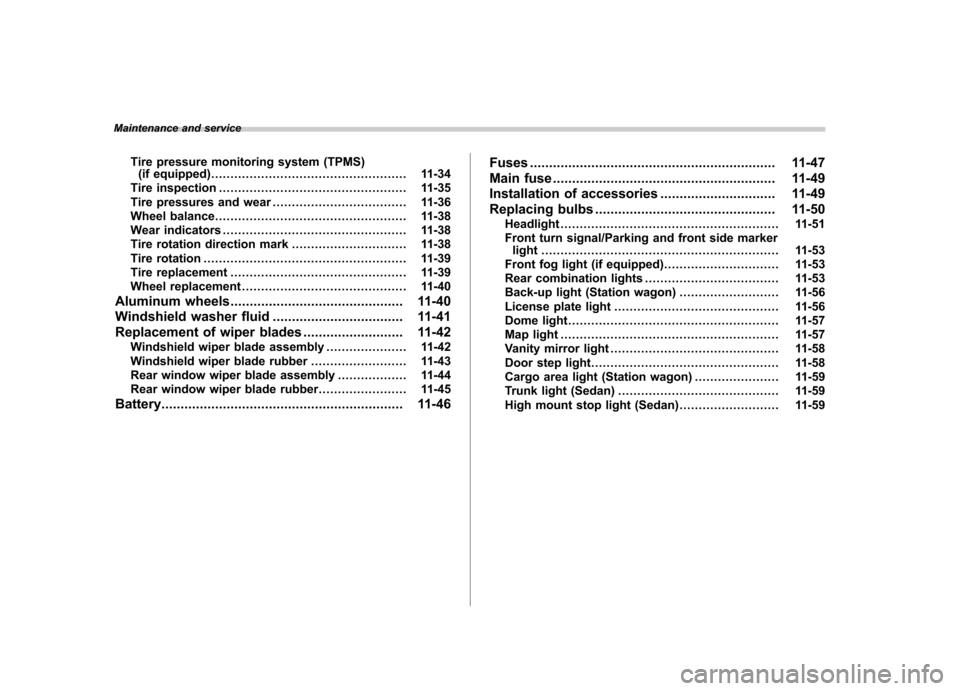
Maintenance and serviceTire pressure monitoring system (TPMS)(if equipped) ................................................... 11-34
Tire inspection ................................................. 11-35
Tire pressures and wear ................................... 11-36
Wheel balance .................................................. 11-38
Wear indicators ................................................ 11-38
Tire rotation direction mark .............................. 11-38
Tire rotation ..................................................... 11-39
Tire replacement .............................................. 11-39
Wheel replacement ........................................... 11-40
Aluminum wheels ............................................. 11-40
Windshield washer fluid .................................. 11-41
Replacement of wiper blades .......................... 11-42
Windshield wiper blade assembly ..................... 11-42
Windshield wiper blade rubber ......................... 11-43
Rear window wiper blade assembly .................. 11-44
Rear window wiper blade rubber ....................... 11-45
Battery. .............................................................. 11-46 Fuses
................................................................ 11-47
Main fuse .......................................................... 11-49
Installation of accessories .............................. 11-49
Replacing bulbs ............................................... 11-50
Headlight ......................................................... 11-51
Front turn signal/Parking and front side marker light .............................................................. 11-53
Front fog light (if equipped) .............................. 11-53
Rear combination lights ................................... 11-53
Back-up light (Station wagon) .......................... 11-56
License plate light ........................................... 11-56
Dome light ....................................................... 11-57
Map light ......................................................... 11-57
Vanity mirror light ............................................ 11-58
Door step light ................................................. 11-58
Cargo area light (Station wagon) ... ................... 11-59
Trunk light (Sedan) .......................................... 11-59
High mount stop light (Sedan) .......................... 11-59
Page 354 of 447
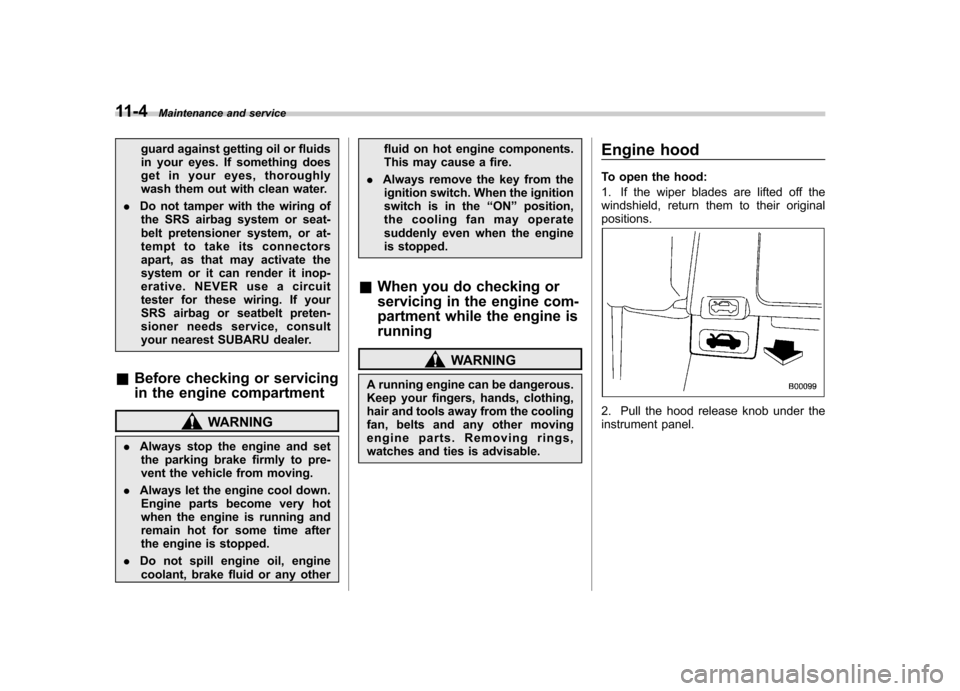
11-4Maintenance and service
guard against getting oil or fluids
in your eyes. If something does
get in your eyes, thoroughly
wash them out with clean water.
. Do not tamper with the wiring of
the SRS airbag system or seat-
belt pretensioner system, or at-
tempt to take its connectors
apart, as that may activate the
system or it can render it inop-
erative. NEVER use a circuit
tester for these wiring. If your
SRS airbag or seatbelt preten-
sioner needs service, consult
your nearest SUBARU dealer.
& Before checking or servicing
in the engine compartment
WARNING
. Always stop the engine and set
the parking brake firmly to pre-
vent the vehicle from moving.
. Always let the engine cool down.
Engine parts become very hot
when the engine is running and
remain hot for some time after
the engine is stopped.
. Do not spill engine oil, engine
coolant, brake fluid or any other fluid on hot engine components.
This may cause a fire.
. Always remove the key from the
ignition switch. When the ignition
switch is in the “ON ”position,
thecoolingfanmayoperate
suddenly even when the engine
is stopped.
& When you do checking or
servicing in the engine com-
partment while the engine is running
WARNING
A running engine can be dangerous.
Keep your fingers, hands, clothing,
hair and tools away from the cooling
fan, belts and any other moving
engine parts. Removing rings,
watches and ties is advisable. Engine hood
To open the hood:
1. If the wiper blades are lifted off the
windshield, return them to their originalpositions.
2. Pull the hood release knob under the
instrument panel.
Page 392 of 447
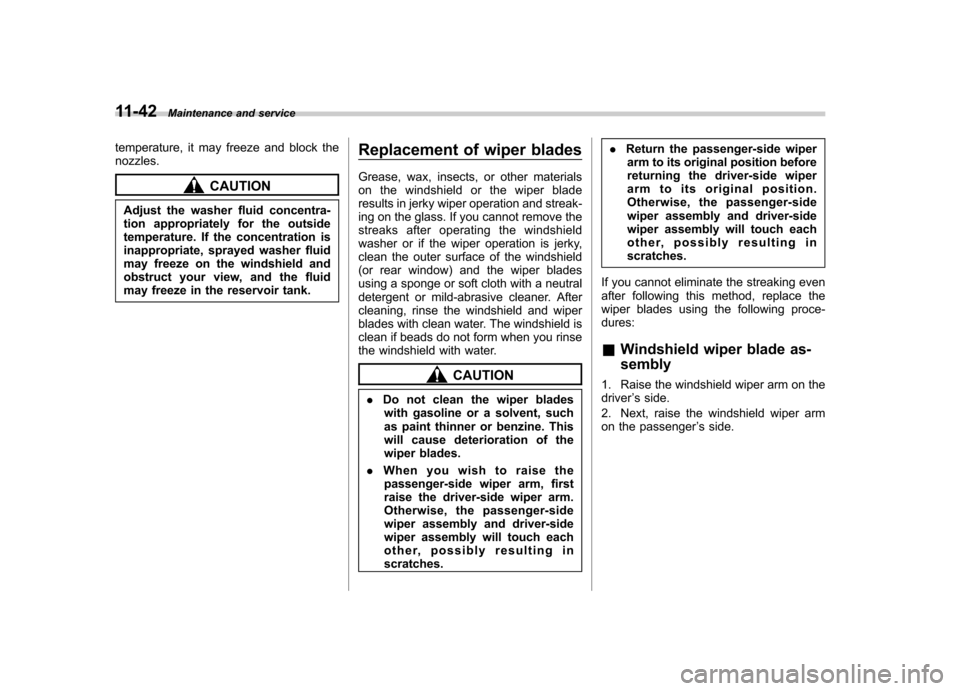
11-42Maintenance and service
temperature, it may freeze and block the nozzles.
CAUTION
Adjust the washer fluid concentra-
tion appropriately for the outside
temperature. If the concentration is
inappropriate, sprayed washer fluid
may freeze on the windshield and
obstruct your view, and the fluid
may freeze in the reservoir tank. Replacement of wiper blades
Grease, wax, insects, or other materials
on the windshield or the wiper blade
results in jerky wiper operation and streak-
ing on the glass. If you cannot remove the
streaks after operating the windshield
washer or if the wiper operation is jerky,
clean the outer surface of the windshield
(or rear window) and the wiper blades
using a sponge or soft cloth with a neutral
detergent or mild-abrasive cleaner. After
cleaning, rinse the windshield and wiper
blades with clean water. The windshield is
clean if beads do not form when you rinse
the windshield with water.
CAUTION
. Do not clean the wiper blades
with gasoline or a solvent, such
as paint thinner or benzine. This
will cause deterioration of the
wiper blades.
. Whenyouwishtoraisethe
passenger-side wiper arm, first
raise the driver-side wiper arm.
Otherwise, the passenger-side
wiper assembly and driver-side
wiper assembly will touch each
other, possibly resulting inscratches. .
Return the passenger-side wiper
arm to its original position before
returning the driver-side wiper
arm to its original position.
Otherwise, the passenger-side
wiper assembly and driver-side
wiper assembly will touch each
other, possibly resulting inscratches.
If you cannot eliminate the streaking even
after following this method, replace the
wiper blades using the following proce-dures: & Windshield wiper blade as- sembly
1. Raise the windshield wiper arm on the driver ’s side.
2. Next, raise the windshield wiper arm
on the passenger ’s side.
Page 441 of 447

N
New vehicle break-in driving.......................................... 8-2
OOdometer .................................................................. 3-25
Odometer/Trip meter .................................................. 3-10
Off road driving ............................................................ 8-6
Oil filter .................................................................... 11-10
Oil level Engine .................................................................. 11-9
Front differential gear ............................................ 11-24
Manual transmission .............................................. 11-21
Rear differential .................................................... 11-25
Oil pressure warning light ............................................ 3-32
Outside mirrors .......................................................... 3-57
Outside temperature indicator ...................................... 3-42
Overhead console ........................................................ 6-7
Overheating engine .................................................... 9-13
PParking Brake ................................................................... 7-45
Brake stroke ......................................................... 11-33
Light switch ........................................................... 3-48
Tips...................................................................... 7-45
Parking your vehicle ................................................... 7-44
Periodic inspections ..................................................... 8-4
Petrol fuel ................................................................... 7-3
Pocket ........................................................................ 6-8
Power
Door locking switch .................................................. 2-7 Seat
....................................................................... 1-4
Steering ................................................................ 7-34
Steering fluid ........................................................ 11-27
Windows ............................................................... 2-21
Precautions against vehicle modification ................ 1-27, 1-66
Preparing to drive ........................................................ 7-8
Printed antenna ........................................................... 5-2
RRear Combination lights ................................................ 11-53
Gate ............................................................. 2-27, 9-18
Seats ..................................................................... 1-9
Viscous limited slip differential .................................. 7-33
Rear differential Gear oil ............................................................... 11-25
Rear seat
Folding down .......................................................... 1-9
Rear turn signal ........................................................ 11-53
Rear window
Defogger button ..................................................... 3-54
Wiper and washer switch ......................................... 3-53
Wiper blades ........................................................ 11-44
Recommended
Automatic transmission fluid ................................... 11-23
Brake fluid ........................................................... 11-29
Clutch fluid .......................................................... 11-30
OIL grade and viscosity ..................... 11-12, 11-13, 11-22, 11-25, 11-27
Power steering fluid .............................................. 11-28
Spark plugs ......................................................... 11-20 Index
14-7
Page 442 of 447

14-8Index
Refueling .................................................................... 7-5
Remote engine start system ........................................ 7-11
Remote keyless entry system ........................................ 2-8
Replacement Brake pad and lining ............................................. 11-32
Wiper blades ........................................................ 11-42
Replacing Air cleaner element ............................................... 11-18
Battery (remote keyless entry system) ...................... 2-11
Lost transmitters (remote keyless entry system) . ........ 2-13
Replacing bulbs ........................................................ 11-50
Back-up light (Sedan) ............................................ 11-53
Back-up light (Station wagon) ................................. 11-56
Brake/Tail and rear side marker light (Sedan) ........... 11-53
Brake/Tail light (Station wagon) ............................... 11-54
Cargo area light .................................................... 11-59
Dome light ........................................................... 11-57
Door step light ...................................................... 11-58
Front fog light ....................................................... 11-53
Headlight ............................................................. 11-51
High mount stop light ............................................. 11-59
License plate light ................................................. 11-56
Map light .............................................................. 11-57
Rear combination light ........................................... 11-53
Rear side marker light (Station wagon) .................... 11-54
Trunk light ............................................................ 11-59
Vanity mirror light .................................................. 11-58
Rocking the vehicle .................................................... 8-13
Roof rail and crossbar ................................................ 8-15 S
S# PREP indicator light
............................................... 3-39
Safety
Precautions when driving ............................................. 4
Symbol ...................................................................... 2
Warnings ................................................................... 2
Seat Fabric ................................................................... 10-5
Heater .................................................................... 1-8
Memory function ...................................................... 1-5
Seat height adjustment ................................................. 1-4
Seatbelt. ........................................................................ 4
Maintenance .......................................................... 1-23
Pretensioners ......................................................... 1-24
Safety tips ............................................................. 1-13
Warning light and chime .................................. 1-15, 3-29
Seatbelts ................................................................... 1-13
Security ID plate .......................................................... 2-3
Security indicator light .......................................... 2-4, 3-38
Selector lever ..................................................... 7-19, 7-25
Position indicator ............................................ 3-39, 3-40
Shift lock release ................................................ 7-24, 7-30
Shift-up indicator light .................................................. 3-38
Shock sensors ........................................................... 2-20
Shopping bag hook ..................................................... 6-13
SI-DRIVE mode. ......................................................... 7-31
Snow tires ....................................................... 8-11, 11-34
Snowy and icy roads ................................................... 8-9
Sounding a panic alarm .............................................. 2-11
Spark plugs ............................................................. 11-20
Specifications ............................................................. 12-2